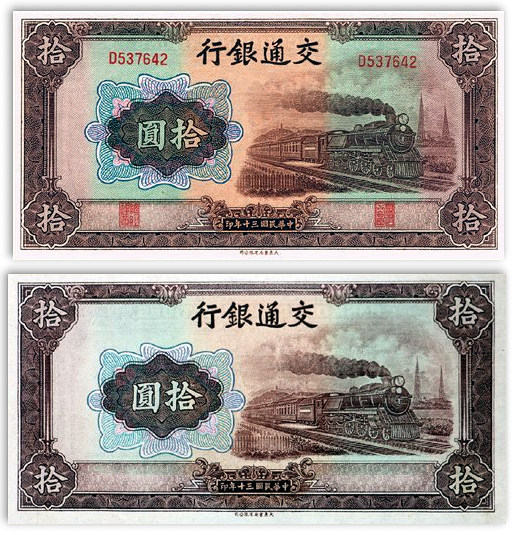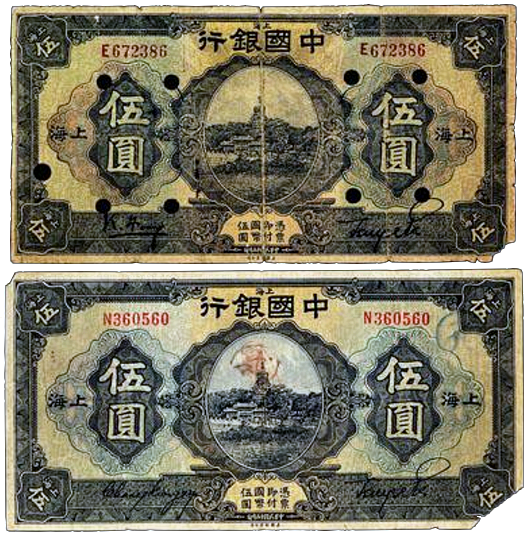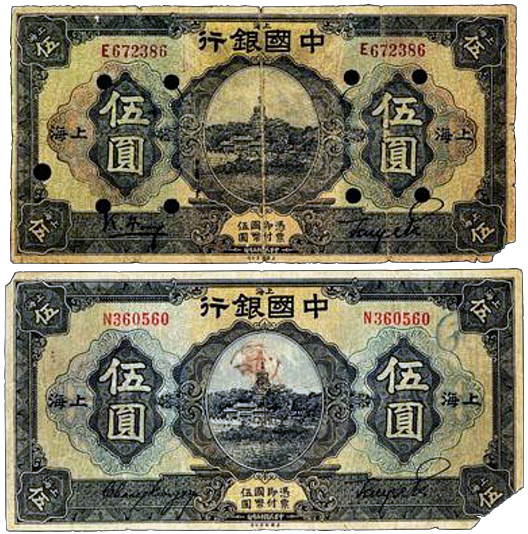Updated November 01 2017
Old Counterfeits |
Return to the 'Fakes and Forgeries' Index |
Forgeries made during the period of issue of the original note are a fascinating area for collecting and study, and such items are the one type of forgery that in most cases you do want to find in your collection. Such currency is far scarcer and nearly always more valuable now than the original note, at least in the case of commonplace notes.
Both individuals and larger criminal gangs have been forging paper currency since it's introduction, and with varying degrees of success. Some forgeries are very difficult to spot while others are almost laughable in their incompetence, though sometimes even fairly obvious forgeries can be found heavily circulated, with some seemingly never having been identified.
Not all forgeries are the product of straightforward criminal activity. During periods of conflict, a common weapon against an enemy government is to flood their areas of control with fake money to destablise their economy, spreading discontent and therefore weakening their support and control. This tactic was used widely during World War II in Europe and Asia. The Japanese widely counterfeited the issues of the Chinese Nationalist government banks; sometimes using the original printing plates when Shanghai and Hong Kong came under their control. The Norborito Army Laboratory in Japan was responsible for creating and printing many of the forgeries (see below), though unfortunately the detailed records of their activities were destroyed at the time of Japan's surrender in 1945. The Communists are also believed to have forged nationalist currency. The Nationalists in turn greatly forged Japan's money and that of it's 'puppet banks' in occupied regions of China.
Both individuals and larger criminal gangs have been forging paper currency since it's introduction, and with varying degrees of success. Some forgeries are very difficult to spot while others are almost laughable in their incompetence, though sometimes even fairly obvious forgeries can be found heavily circulated, with some seemingly never having been identified.
Not all forgeries are the product of straightforward criminal activity. During periods of conflict, a common weapon against an enemy government is to flood their areas of control with fake money to destablise their economy, spreading discontent and therefore weakening their support and control. This tactic was used widely during World War II in Europe and Asia. The Japanese widely counterfeited the issues of the Chinese Nationalist government banks; sometimes using the original printing plates when Shanghai and Hong Kong came under their control. The Norborito Army Laboratory in Japan was responsible for creating and printing many of the forgeries (see below), though unfortunately the detailed records of their activities were destroyed at the time of Japan's surrender in 1945. The Communists are also believed to have forged nationalist currency. The Nationalists in turn greatly forged Japan's money and that of it's 'puppet banks' in occupied regions of China.
The Noborito Army Laboratory in Japan
|
The wartime currency forgery by the Japanese was on a massive scale with hundreds of millions of yuan in forged notes being transferred to mainland China every month. This was part of Japan's wartime strategy to undermine the Nationalist regime of Chiang Kai Shek by disrupting, even ruining the economy. Much of this money was circulated through it's distribution to occupying Japanese troops, and by collaboration with criminal gangs in Shanghai (c. below: 1941 10 yuan, P159a). Some of this currency may have been forged from the original engraving plates as the Dah Tung plant fell under Japanese control in 1941. Right: the lower note is an example of an unfinished forgery of the Bank of Communications 1941 10 yuan (P159a), of a sheet of forgeries found at the site of the Norborito Laboratory. The upper note is a genuine example for comparison.
|
The Nationalists in turn developed their own scheme, forging issues of the puppet banks (such as the 1940 5 and 10 yuan of the Central Reserve Bank of China) for similar purposes.
The Japanese forgeries are also thought to include 5 yuan issues (of the Bank of China and Central Bank), the 1940 Bank of China 10 yuan issue depicting Sun Yatsen (the ABNCo note). Also the 1, 5 and 10 yuan notes of the Farmers Bank of China (forged in April 1940). Further the capture of millions of partially completed notes and the forgery itself are most likely the principle reasons for the decision by the Nationalist government at Chungking (Chongqing) to restrict currency issue to the Central Bank of China, from 1942.
The Japanese forgeries are also thought to include 5 yuan issues (of the Bank of China and Central Bank), the 1940 Bank of China 10 yuan issue depicting Sun Yatsen (the ABNCo note). Also the 1, 5 and 10 yuan notes of the Farmers Bank of China (forged in April 1940). Further the capture of millions of partially completed notes and the forgery itself are most likely the principle reasons for the decision by the Nationalist government at Chungking (Chongqing) to restrict currency issue to the Central Bank of China, from 1942.
An article on the Japanese forgeries:
|
"RESEARCHERS: JAPANESE ARMY USED PRIVATE PAPER MILL TO COUNTERFEIT CHINESE BILLS IN WAR
Posted by Nobuyuki Watanabe, Staff Writer, Asahi Shimbun on 1/27/2015 The Imperial Japanese Army used a private sector company to produce an abundance of counterfeit banknotes that helped to advance Japan’s front lines in China during the Second Sino-Japanese War, a recent discovery shows. Researchers at Meiji University studied 279 sheets, each about 30 centimetres square, that were left at Tomoegawa Co.’s paper mill in Shizuoka. They concluded that the sheets were part of the army’s operation to fake banknotes used in the Republic of China during the war. The army’s Noborito institute in Kawasaki had placed an order for the sheets with the Tokyo based company. This suggests the army institute was involved in not only developing biological weapons, balloon bombs, toxins and other confidential defence technology but also in counterfeiting money. The remains of the army institute are now preserved as the university’s Noborito Institute Peace Education Resource Center, which opened in 2010 in Tama Ward. According to the researchers, the sheets showed watermarks of a profile of Sun Yatsen, the Chinese revolutionary and founding father of the Republic of China. They also contain silk fibers. These features are identical to those of a 5 yuan banknote that was widely circulated in the Republic of China at that time. Other sheets found at the mill had watermarks of the Temple of Heaven, a historic structure in Beijing, that appeared on a different kind of 5 yuan bill back then. A former Imperial Japanese Army officer who was in charge of the counterfeiting project wrote in a postwar book that the operation had created fake bills worth 4 billion yuan since its start in 1939. Akira Yamada, professor of modern Japanese history at Meiji University, said it had long been thought that paper for the fake bills was produced only at the army institute because of the highly confidential nature of the operation. “Having a company in the private sector involved in the project made it possible to make a vast volume of banknotes,” said Yamada, who is also head of the Noborito institute. “Japan was able to expand its battle lines in China apparently because it could secure supplies to continue fighting with a wealth of forged banknotes.” The sheets were produced between August 1940 and July 1941, the researchers said, citing the letters printed on them. There were also signs that workers ensured the bills looked authentic by checking the sophistication of the watermarks and the amount of silk fibres used. According to the Noborito institute, authentic banknotes used in the Republic of China were printed in Hong Kong using technology from the United States and Britain. Former employees with the army institute have testified that the machines and original plates to print the bills in Hong Kong were confiscated and taken to the institute after Japan occupied Hong Kong in 1941. Some historians said the army facility was unable to produce as many fake bills as Japan had hoped for. It was located on a hill, making it difficult to secure a steady water supply for the production of the paper. The researchers’ findings came after they sent inquiries to companies that had business dealings with the army institute, which was inaugurated in 1937. Most of the army institute’s facilities and documents were destroyed when Japan was defeated in 1945" This article was originally written by Nobuyuki Watanabe and published January 6, 2015 on the Asahi Shimbun website. |
Some examples of period forgeries
Chinese government banks forgeries
The Bank of China
The Central Bank of China
|
Right: two different forgeries of the '1930' 5 Dollars. Clearly produced by two different forgers and most likely several years apart as the signatures in theory date the upper example to around 1935-1940, and the lower to the early 1930s. The upper note is of noticeably poor quality; in particular the portrait and the off-colour underprint guilloches. Another peculiarity is the lack of serial numbers which may suggest that this was a poor attempt to fake the final version of this note - but it has the wrong signatures. |
Hong Kong Banks





